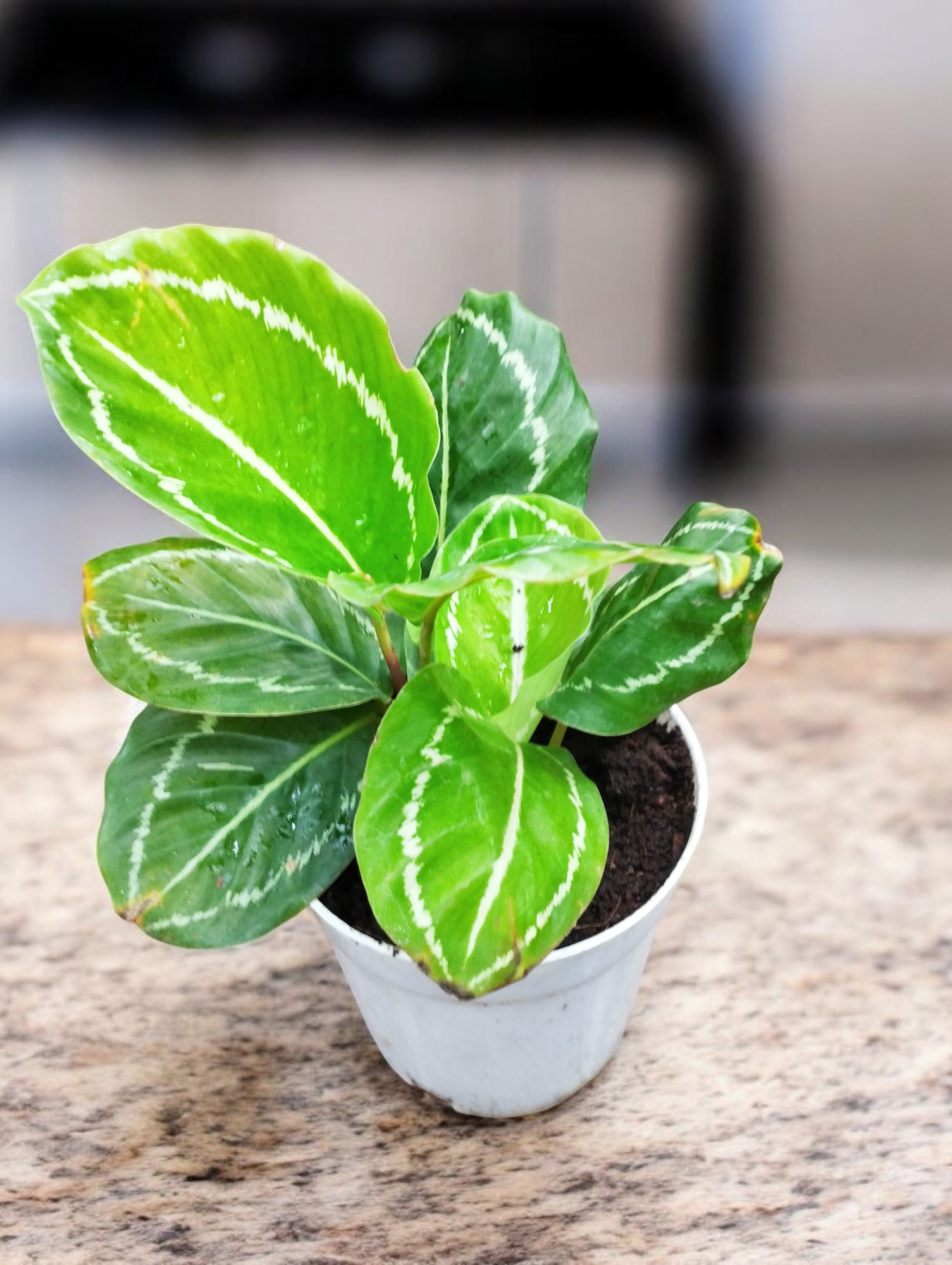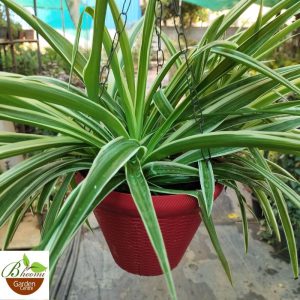Calathea JF Macbrideana
This product is available for shipping only in Bangalore
Calathea Macbrideana Live Plant will instantly uplift your indoor space! Its vibrant green leaves with striking white-cream lines bring an exotic touch. With simple care of bright, indirect sunlight and regular watering, this lively plant thrives effortlessly. This is one of the rare Calathea plants that will make your guests wonder how you got a hold of this tropical beauty.
Plant Height: approx 12 inches including the pot
Pot size : 5 inches nursery pot
- Estimated Delivery : Up to 3 business days
- Free Shipping & Returns : On all orders over ₹550 in Bangalore
Calathea JF Macbrideana or Calathea JF Macbr commonly referred to as Calathea Macbrideana, is a lesser-known yet attractive member of the Calathea family. Like other Calathea species, it is native to the tropical rainforests of South America, where it thrives in warm, humid conditions. This variety is admired for its beautiful foliage, characterized by broad, lance-shaped leaves with subtle patterns, often featuring shades of green with light green or creamy white markings. The undersides of the leaves are typically a deep purple or maroon, adding to its visual appeal.
Caring for Calathea JF Macbrideana requires a bit of attention, especially in maintaining the right light, moisture, and humidity conditions. Here’s a comprehensive guide to help your Calathea JF Macbrideana thrive:
1. Light Requirements
- Bright, Indirect Light: Calathea Macbrideana prefers bright, indirect light. Place it near a window with filtered sunlight or in a room that receives plenty of natural light. Direct sunlight can cause the leaves to scorch and lose their color.
- Low Light Tolerance: This plant can tolerate lower light levels, making it suitable for indoor environments. However, avoid very dark conditions, as insufficient light can lead to slower growth and less vibrant foliage.
2. Watering
- Keep Soil Consistently Moist: Water the plant regularly to keep the soil consistently moist but not waterlogged. Use lukewarm, distilled, or filtered water to avoid the chemicals and salts commonly found in tap water. Allow the top inch of soil to dry out slightly between waterings.
- Humidity is Crucial: Calathea Macbrideana thrives in high humidity. Aim for a humidity level of 60-80%. Increase humidity by misting the leaves regularly, placing a humidity tray nearby, or using a humidifier. This is particularly important during dry seasons or in climates with low humidity.
3. Soil
- Well-Draining, Peat-Based Soil: Use a well-draining potting mix that retains moisture but allows excess water to drain away. A mix of peat moss, perlite, and regular potting soil works well. This helps keep the roots healthy and prevents root rot.
- Slightly Acidic to Neutral pH: A soil pH of around 6.0 to 6.5 is ideal for Calathea Macbrideana, ensuring optimal nutrient uptake.
4. Temperature and Humidity
- Warm Temperatures: Maintain temperatures between 65-80°F (18-27°C). Calathea Macbrideana is sensitive to cold and should be protected from temperatures below 60°F (15°C) as well as cold drafts and air conditioning vents.
- High Humidity: Consistently high humidity is essential for healthy growth. Low humidity can cause the leaf edges to brown or curl. Using a humidifier or placing the plant in a naturally humid room (like a bathroom) can help maintain ideal conditions.
5. Fertilizing
- Feed Regularly During Growing Season: Fertilize every 4-6 weeks during the spring and summer with a balanced, water-soluble fertilizer diluted to half strength. This encourages healthy growth and vibrant foliage.
- Reduce Fertilizing in Fall and Winter: During the plant’s dormant period, reduce fertilizing to avoid overfeeding.
6. Pruning and Maintenance
- Remove Yellow or Damaged Leaves: Trim off any yellowing or damaged leaves with clean, sharp scissors to maintain the plant’s appearance and promote healthy growth. Regularly check for signs of stress or pests.
- Dust and Clean Leaves: Dust can accumulate on the leaves, hindering photosynthesis. Wipe the leaves with a damp cloth periodically to keep them clean and allow the plant to absorb light efficiently.
7. Propagation
- Division: The most effective method of propagating Calathea Macbrideana is by division. This is best done during repotting. Carefully separate the plant into smaller sections, ensuring each section has roots and healthy leaves. Plant the divisions in separate pots with fresh soil.
- Stem Cuttings: Calathea Macbrideana is not typically propagated from stem cuttings, as it does not root well this way.
8. Pests and Diseases
- Common Pests: Watch for pests such as spider mites, aphids, and mealybugs. Regularly inspect the plant and use insecticidal soap, neem oil, or a mild dish soap solution to treat infestations.
- Fungal Issues: Overwatering and poor air circulation can lead to fungal problems like root rot. Ensure the pot has good drainage and avoid letting the plant sit in waterlogged soil.
9. Indoor Growing
- Suitable for Indoor Conditions: Calathea Macbrideana is well-suited for indoor environments, especially because of its tolerance for lower light levels. It is a great choice for brightening up spaces such as living rooms, bedrooms, and offices.
- Air Purifying: Like other Calatheas, it can help improve indoor air quality by removing toxins such as formaldehyde and benzene.
10. Toxicity
- Non-Toxic: Calathea Macbrideana is non-toxic to pets and humans, making it a safe addition to households with children or pets.
11. Container and Repotting
- Pot Requirements: Choose a pot with drainage holes to prevent waterlogging. Use a high-quality, well-draining potting mix and consider repotting every 1-2 years or when the plant becomes root-bound. Repotting provides fresh nutrients and room for growth.
- Decorative Containers: Calathea Macbrideana looks beautiful in decorative pots that complement its striking foliage. Ensure the pot size is appropriate for the plant’s growth.
12. Overwintering
- Indoor Protection: If grown outdoors in summer, bring the plant indoors before the first frost. Keep it in a bright location with indirect light and maintain humidity levels to ensure the plant remains healthy during winter.
By providing the right conditions and care, your Calathea Macbrideana will thrive, showcasing its elegant foliage and adding a tropical touch to your home. This plant is relatively low maintenance but requires consistent care regarding light, moisture, and humidity to remain vibrant and healthy.
** Plants photos are for representation purpose only. We will make best efforts to send the plants as in photos itself. There may be small white dots on the plant, as these plants cared in nursery using the hard water and pesticide spray. However these will eventually disappear as you take care and clean the leaves. Trust us, we want to give you the best














Reviews
There are no reviews yet.